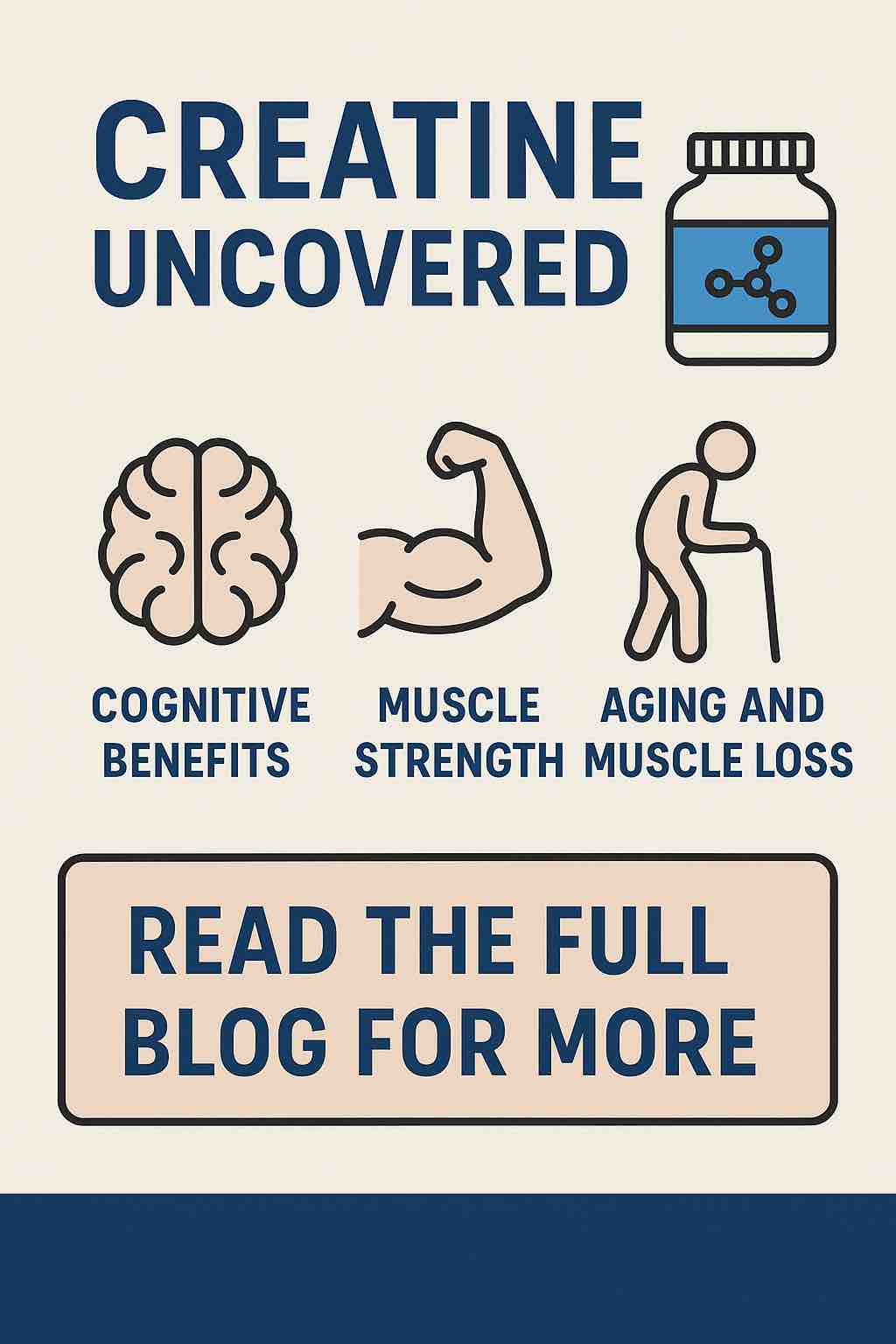
The Rise of a Super Supplement
Once confined to the gym bags of professional athletes and bodybuilders, creatine has broken out of its muscle-bound stereotype. From neuroscience labs to wellness circles, creatine is now earning recognition for its broad-ranging health benefits — many of which go far beyond bulking up. But as its popularity grows, so does the misinformation.
This post aims to demystify creatine by diving deep into the science, benefits, myths, safety, and its evolving role in cognitive and physical health.
Section 1: What Is Creatine? A Quick Primer
Creatine is a naturally occurring compound found in small amounts in foods like red meat and fish and synthesized by the body — mainly in the liver, kidneys, and pancreas. It is stored primarily in skeletal muscle and used during high-intensity, short-duration activities such as sprinting or heavy lifting.
The majority of creatine in our bodies is stored as phosphocreatine, which helps regenerate ATP — our cells’ primary energy currency. This quick energy system is crucial for muscle performance and increasingly recognized for brain energy metabolism.
Section 2: The Proven Benefits of Creatine
💪 1. Physical Performance and Muscle Health
- Increased Strength & Power Output: Creatine supplementation improves high-intensity exercise capacity, making it a go-to for strength athletes.
- Enhanced Muscle Growth: Through water retention in muscle cells and better training volume, it supports hypertrophy.
- Faster Recovery: Creatine has been shown to reduce muscle damage and inflammation post-exercise.
🧾 A 2024 meta-analysis found that creatine increased upper- and lower-body strength in adults under 50, with pronounced effects in males engaging in resistance training.
— PubMed ID: 39519498
🧓 2. Aging Gracefully: Muscle Preservation in Older Adults
Sarcopenia — the age-related loss of muscle mass and strength — is a major concern for older populations. Creatine, especially when paired with resistance training, significantly slows down muscle loss and improves functionality in older adults.
🧾 A 2025 study reported that individuals over 60 experienced higher gains in lean mass and lower fall risk when supplementing with creatine during training.
— Washington Post Wellness
🧠 3. Cognitive and Neurological Advantages
One of the most exciting frontiers in creatine research is its impact on the brain:
- Improved Memory & Focus: Especially under stress or sleep deprivation.
- Neuroprotection: Ongoing research links creatine to delayed onset of neurodegenerative diseases such as Parkinson’s and Alzheimer’s.
- Enhanced Processing Speed: A 2024 study published in Nature found that creatine improved cognitive response times in sleep-deprived individuals.
🧾 Creatine may act as a buffer in brain energy metabolism, supporting neurotransmitter synthesis and brain cell survival under stress.
— Nature Scientific Reports, 2024
Section 3: Addressing the Myths and Misinformation
Despite decades of study, creatine still suffers from persistent myths. Let’s debunk them with science.
❌ Myth 1: Creatine Causes Kidney Damage
This claim stems from early misinterpretations of creatinine levels (a metabolite of creatine). In healthy individuals, no evidence supports renal damage from standard doses (3–5 g/day).
✅ Clinical studies over months and years show no negative impact on kidney or liver health in healthy adults.
— Healthline, 2024
❌ Myth 2: Creatine Leads to Hair Loss
One small study linked creatine to increased DHT, a hormone associated with hair loss. But:
- The rise was modest and not consistent across studies.
- No direct evidence shows creatine causes hair loss.
✅ Experts agree the connection is speculative at best.
— FitnessSimplified.org, 2024
❌ Myth 3: It’s Just Water Weight
Creatine does cause initial intramuscular water retention, which actually supports cell hydration and protein synthesis. Over time, gains are attributed to increased muscle fiber size and performance — not just water.
Section 4: Who Should Consider Creatine?
🧍♂️ 1. Athletes & Fitness Enthusiasts
From sprinters to lifters, anyone engaging in anaerobic activity can benefit.
🧠 2. Students, Night Shift Workers, and Executives
Creatine may enhance mental clarity during stress, sleep deprivation, and multitasking.
👴 3. Aging Populations
Especially those involved in resistance training — creatine slows muscular decline and may improve cognitive resilience.
👩 4. Women
Often overlooked, but creatine supports cognitive health, mood stability, and muscle maintenance — particularly in perimenopausal and postmenopausal women.
🔍 Fun Fact: Studies suggest women may benefit more cognitively from creatine due to naturally lower baseline creatine stores.
Section 5: How to Supplement Safely
- Loading Phase (Optional): 20 g/day split into 4 doses for 5–7 days.
- Maintenance: 3–5 g/day thereafter.
- Timing: Pre- or post-workout is ideal, though consistency is more important than timing.
💧 Hydration is key, as creatine draws water into muscles.
Section 6: Creatine Forms – Which Is Best?
| Type | Pros | Cons |
|---|---|---|
| Creatine Monohydrate | Most researched, cost-effective | Mild bloating in some |
| Micronized Creatine | Smaller particles, easier to mix | Slightly more expensive |
| Creatine HCl | Less water retention | Less evidence |
| Buffered Creatine (Kre-Alkalyn) | Marketed for pH stability | No added benefit proven |
🎯 Verdict: Stick with creatine monohydrate unless you experience GI discomfort.
Section 7: Final Thoughts – The Creatine Renaissance
Creatine is no longer just a “gym bro” supplement. It’s a multi-faceted compound with compelling research supporting its role in physical performance, aging, brain health, and recovery. As always, consult with a healthcare provider before starting, especially if you have underlying conditions.
As science progresses, it’s becoming clear: Creatine isn’t just for bodybuilders — it’s for everyone.
Have You Tried Creatine?
Drop your experiences or questions in the comments — let’s keep the conversation science-backed and open-minded.
📌 Frequently Asked Questions (FAQs)
1. Is creatine safe for long-term use?
Yes. Decades of research show that creatine is safe for long-term use in healthy individuals when taken at recommended doses (3–5 grams/day). It does not harm kidney or liver function in those without pre-existing conditions.
2. Do I need to cycle creatine?
No. Cycling is not necessary. Continuous daily supplementation is effective and safe. However, some users choose to cycle for personal preference or psychological break.
3. Should I take creatine before or after a workout?
Either works, but studies suggest taking creatine post-workout may offer a slight advantage in muscle recovery and growth. Consistency is more important than timing.
4. Can creatine help with weight loss?
Indirectly. Creatine itself doesn’t burn fat, but by improving workout performance and preserving muscle mass, it can support fat loss efforts more effectively when combined with proper training and diet.
5. Is creatine just for men?
Not at all. Women can benefit from creatine for improved muscle tone, cognitive function, and hormonal support, especially during perimenopause and menopause. Studies show women may respond particularly well due to lower baseline creatine levels.
6. Will creatine make me bulky or cause water retention?
Creatine may cause minor initial water retention inside muscles, giving a fuller look, not bloating. It supports lean muscle growth, but won’t make you bulky without intense training and high-calorie intake.
7. Does creatine cause hair loss?
No conclusive evidence exists. The belief stems from one small study with increased DHT levels — not hair loss itself. Most large-scale studies do not support the link between creatine and hair thinning or balding.
8. Can vegetarians and vegans benefit more from creatine?
Yes. Plant-based diets contain little to no creatine, so vegetarians and vegans often have lower baseline levels. Supplementation can lead to more noticeable improvements in strength and cognitive performance.
9. What age is safe to start creatine?
Most research supports creatine use for individuals 18 and older. Some studies suggest safety in younger athletes, but professional guidance is recommended for minors.
10. What happens if I stop taking creatine?
You’ll gradually lose the performance and strength benefits as your body returns to baseline levels over 2–4 weeks. There are no withdrawal effects, and it’s completely safe to stop at any time.













